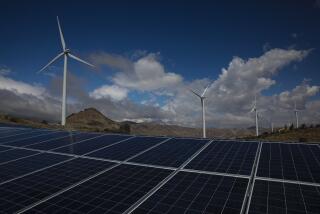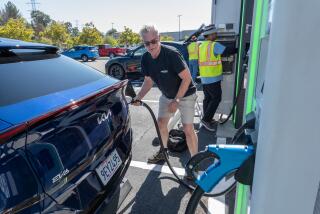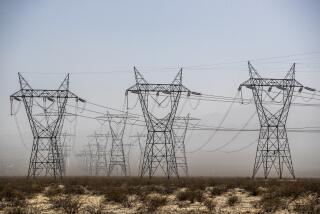Thorny issues challenge California’s commitment to renewable energy goals
As California pushes forward on its ambitious goal to produce 50% of its electricity from renewable sources by 2030, it will confront a wide range of potentially troubling economic, technical and political questions — though there remains strong support among public officials for the state’s climate program.
The state is demonstrating to the rest of the nation and the world that it has the deep political willpower to address climate change, but it has yet to fully understand the impacts of the program on low-income residents, economic growth and electrical grid reliability.
“There is a regressive nature to some of these things,” Lt. Gov. Gavin Newsom said Friday, noting that more than 1 million state households spend more than 10% of their income on energy. “We have to be sensitive to issues relating to energy costs.”
Newsom’s remarks came at a Los Angeles Times conference on renewable energy in Santa Monica. Academics, regulators, fossil fuel executives and renewable energy proponents weighed in on the state’s commitment to battling climate change.
The renewable energy goals will require going far beyond putting up new wind turbines and solar array farms, requiring the state to address the many past, present and future energy issues that each have their own unique place in the state’s economic and political landscape.
Newsom, along with the other experts at the Times summit said the 50% goal is “absolutely achievable.” But the experts have sharply divided opinions about how deeply the state will have to restructure its energy system and the impacts it will have in on an economy that already has some of the nation’s highest-priced electricity.
Loretta Lynch, a panelist who was formerly president of the California Public Utilities Commission, said in an interview that high electricity prices are part of the reason that the Los Angeles region has economically stagnated for more than two decades, but she laid the blame on regulatory decisions that have supported too much “gold plated” natural-gas powered generating capacity.
Lynch asserts that state regulators have grossly overestimated the amount of power needed to back up renewable energies.
The current protocols require at least some gas-fired plants to have their turbines hot and spinning, ready to deliver power to the grid in seconds if the sun should suddenly duck behind a cloud or the wind stop blowing. Even when they aren’t producing power, they are adding to the cost of electricity.
The conference attracted an audience committed to green energy. A rough majority of the people said they had roof top solar systems, drive electric cars or had bicycled to the conference. Their questions reflected opposition to fossil fuels and nuclear power.
Tiffany Roberts, an executive with the Western States Petroleum Assn., reminded naysayers of the importance of her fuels, noting that 2 million gallons of gasoline and diesel are consumed in the state every hour and California is the world’s third-largest market for the products after the entire U.S. and China. Roberts said sales of electric vehicles are now trending down and rely on heavy government subsidies.
Newsom called fossil fuels a “necessary evil,” noting he flew to Los Angeles from Sacramento.
See the most-read stories in Local News this hour >>
George Minter, the “environmental strategist” for SoCalGas, said the state should be moving faster to tap biological production of methane to replace natural gas from wells, a technology that is moving more quickly in Europe than here. And he said excess electricity from solar farms could be used to produce flammable hydrogen that would be blended into the natural gas.
Lyndon Rive, a co-founder of rooftop solar energy company SolarCity, told the conference that grid vulnerability can be mitigated by more widely distributing generating capacity.
The ultimate solution to reliable solar and wind generation will be storage systems, either batteries, flywheels, compressed air or new innovations like the Santa Barbara-based Ares electric train storage system. But so far, none of the systems have been commercially produced at a size that would provide statewide power storage.
Michael Shellenberger, an environmentalist who writes about energy issues, said the state committed a major error in pushing for the closure of the Diablo Canyon nuclear plant, because most of its capacity will be replaced with natural gas.
Shellenberger, who was not on the Times panel, said in an interview the state already depends on gas for 61% of its electricity and could be facing an economic disaster if predictions of a natural gas price spike are accurate. But other experts said the state will need all of its gas turbine power and even more in the future to provide reserves against wind and solar’s unpredictable output.
James Conca, an energy consultant and former geochemist at Los Alamos National Laboratory, said if California fully replaces all of Diablo Canyon’s 18 billion kilowatt hours of annual generating capacity with wind, it will require 3,000 new wind turbines at a cost of $9 billion. “I am not sure regulators will allow that much renewable energy on the grid without back up,” he said.
Patrick Currier, an energy consultant and former congressional energy expert, said that if the state is not careful about driving up electricity prices, it will exacerbate an exodus of industrial manufacturing that has already hollowed out the Los Angeles economy. Even seemingly tiny incremental increases in electricity can cause unexpectedly large cost increases for commercial and industrial users, forcing them out of state.
Newsom acknowledged the state’s key role in influencing the closure of Diablo Canyon, saying it had used “enlightened engagement” to force PG&E, the plant owner, to come to the bargaining table. The shutdown, structured over the next decade, left anti-nuclear activists angry, but the plan will avoid the disruption and possible blackouts that the unplanned San Onofre nuclear power plant shutdown caused, he added.
Newsom said the state will need to address the legal and political uncertainty around its cap and trade auctions, which dispenses credits that allows emitters to release greenhouse gases. The use of that cap and trade money to fund California’s high speed rail system has left him “worried” and remains troubling to a number of Democrats.
“We are back in some muddy water,” he said.
MORE LOCAL NEWS
Hundreds to attend vigil for UC Berkeley student killed in Nice terror attack
‘Pokemon Go’ adds new life to some L.A. neighborhoods by forcing players outside
More to Read
Start your day right
Sign up for Essential California for news, features and recommendations from the L.A. Times and beyond in your inbox six days a week.
You may occasionally receive promotional content from the Los Angeles Times.







